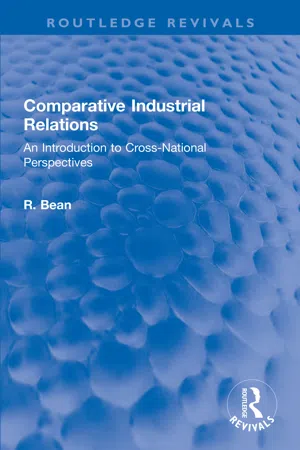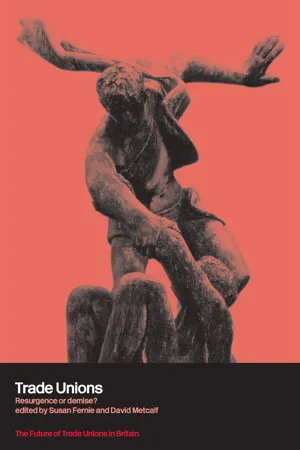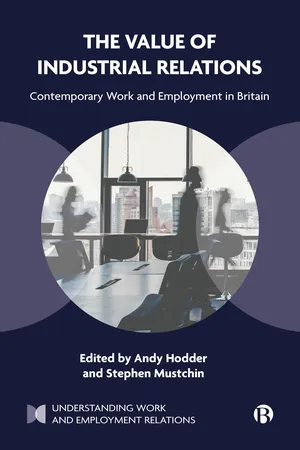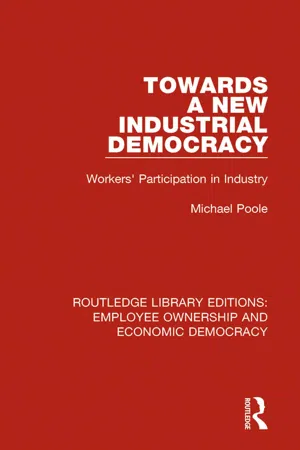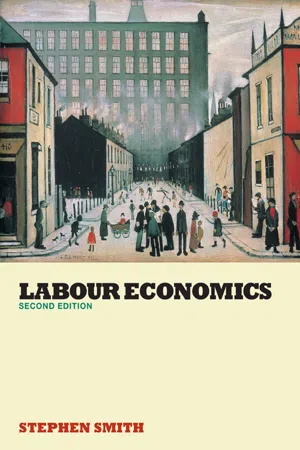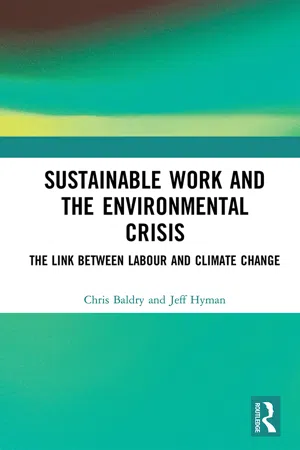Economics
Trade Unions
Trade unions are organizations formed by workers to protect their rights and interests in the workplace. They negotiate with employers on behalf of their members for better wages, working conditions, and benefits. Trade unions also provide support and representation for workers in disputes with management, and they play a role in shaping labor laws and regulations.
Written by Perlego with AI-assistance
Related key terms
Related key terms
1 of 4
Related key terms
1 of 3
10 Key excerpts on "Trade Unions"
- eBook - ePub
Understanding European Trade Unionism
Between Market, Class and Society
- Richard Hyman(Author)
- 2001(Publication Date)
- SAGE Publications Ltd(Publisher)
2
Trade Unions as Economic Actors
Regulating the Labour MarketIn most English-speaking countries, Trade Unions have traditionally been viewed as organizations the primary purpose of which is to secure economic benefits for their members; in particular, by advancing their ‘terms and conditions of employment’ through collective bargaining. From such a perspective, broader social and political objectives are of dubious legitimacy, or at best ancillary to unions’ economic functions.In this chapter I discuss the classic analysis of trade union functions presented by Sidney and Beatrice Webb over a century ago, and the doctrine of ‘business unionism’ which acquired particular force in the USA. In the latter model, industrial relations is perceived as a largely self-contained field of action. Unions succeed best, it is assumed, by their skill and determination in playing the labour market; other forms of union action do not facilitate, and may detract from, unions’ economic goals.Yet it is questionable how far the labour market can be treated as analogous to the general model of commodity markets; and likewise it is misleading to abstract market processes in general from the socio-political environment in which they are located. Accordingly, there is a contradiction at the heart of business unionism: Trade Unions can intervene effectively in regulating the labour market only to the extent that their aims and actions transcend the purely economic. - eBook - ePub
- D Sapsford(Author)
- 2013(Publication Date)
- Routledge(Publisher)
Part Two ECONOMIC ASPECTS OF TRADE UNION BEHAVIOURPassage contains an image Chapter 5
The Economics of Trade Unions
In the previous chapter the determination of the levels of wages and employment was considered in cases where there is perfect competition among sellers of labour. An important characteristic of the UK labour market and that of other industrialised countries is the existence of Trade Unions as organisations of sellers of labour. Trade Unions are complex institutions, which can be analysed from social and political as well as economic viewpoints, but in this chapter we concentrate exclusively on the economic analysis of Trade Unions. There is a large body of literature in the industrial relations or ‘institutional’ school, which stresses the role of social, political and psychological forces in its analysis of trade union structure, government and organisation, and this approach is discussed in detail in Palmer (forthcoming in this series).The present chapter begins with a brief history of Trade Unions in the UK, which is followed by a discussion of the economic theory of union growth together with a summary of the available empirical evidence relating to the theory. In the next section the questions of union objectives and the specification of a model of union behaviour are considered. In the following chapter we consider the determination of wages under collective bargaining and discuss the relative wage effect of Trade Unions (i.e. their impact on the wages of their members relative to those of non-members) and their effect on the allocation of resources. In Chapter 7 the role of Trade Unions in wage inflation is considered.Trade Unions IN THE UK: A BRIEF HISTORY
A trade union was defined by the Royal Commission on Trade Unions and Employers' Associations as ‘any combination of employees the principal activity of which is the regulation of relations between employees and employers’ (Donovan, 1968, p. 207), and these unions have existed in various forms in the UK since the early nineteenth century, if not earlier. Table 5.1 - eBook - ePub
Comparative Industrial Relations
An Introduction to Cross-National Perspectives
- R. Bean(Author)
- 2021(Publication Date)
- Routledge(Publisher)
2 Trade UnionsTrade Unions are institutional representatives of worker interests both within the labour market and in the wider society, and they accentuate the collective rather than the individual power-resources of employees. However, as well as basic similarities there are also major differences as between trade union movements in advanced industrialised countries, not only in the extent of their membership density but also in their role and objectives and the structural divisions that characterise them, which require investigation. In some unions the emphasis is more upon representing aspirations of the working class as a whole rather than functioning as collective bargaining agencies merely for their own members. In the case of France, it has been said (Kendall, 1975) that in the past a worker's decision to join a union represented as much a reflex of class consciousness as any intention to organise practically on his own behalf for enhanced conditions and improved job control. Thus,it would be a commonplace to historians that the union movements in the United States or in Britain are very different in character from the union movements in France or in Italy, each conditioned by its own historical experience, and each with a distinctive conception of its role within the wider society. (Gallie, 1978, p. 33)In much of Western Europe a predominant characteristic has been trade union pluralism (and sometimes reluctance to engage in continuous relationships with employers) promoted by ideological, philosophical and religious differences, although in recent years there has been rather less emphasis upon the importance of religious affinity. As a result, the major dividing lines have been less between the craft and industrial unionism dimensions than between, on the one hand, secular and confessional (generally Catholic) unionism, and reform-oriented (mainly socialist) or revolutionary (communist or syndicalist) unionism on the other (Windmuller, 1974). In Italy, for instance, a unique aspect of the trade union movement has been its formal close ties to various political parties (although somewhat weakened in recent years) whereby there were as many union confederations as political persuasions. Also in that country the unions have been financially supported by the political parties (a reversal of the typical relationship found in, say, Britain or Australia) and the normative stance of the Italian movement is that its role is far more comprehensive than simply bargaining for improved wages and work conditions (Guigni, 1981). Similarly in France, a notable feature is the unions' political pluralism, offering a trinity of communist, socialist and radical Catholic organisations in comparison with the relatively unified movements of West Germany and Britain which are not structurally divided on the basis of religion or politics and have only one coordinating organisational centre (the DGB and TUC, respectively). In fact, Trade Unions may seek to achieve their objectives not only by collective bargaining but also by lobbying the legislature, or by a more fundamental form of political action aimed at transforming society. Moreover, union objectives and orientations are themselves of an extremely diverse nature between different countries and they require further elucidation. - eBook - ePub
Trade Unions
Resurgence or Demise?
- Sue Fernie, David Metcalf(Authors)
- 2013(Publication Date)
- Routledge(Publisher)
From around 1870 and for most of the twentieth century, up to the Thatcher era, the share of labour in national income rose secularly, while that of capital gradually decayed correspondingly. Thus labour won the battle with capital, but without overturning capitalism. Given this switch in income shares away from profit towards pay most economists no longer pay much attention to the perceived inequality in bargaining power between capital and labour. So interest in this rationale for union activity has waned, and has been replaced by a new one which ‘shifts attention from imperfections in the structure of markets to imperfections in employment contracts and internal firm governance’ (Kaufman 2004b: 390). There are three main strands in this approach. First, unions replace individual voice with collective voice which enhances the supply of workplace public goods like safety or flexible working. Second, unions might boost productivity by lowering labour turnover, spoiling the quiet life of managers in monopolistic enterprises and ‘expanding the breadth and depth of employee involvement’. Third, unions lower transactions costs and increase efficiency by providing agency services to workers and firms. For workers, the union provides information (for example on wages in competing plants), monitors the performance of the employer and communicates workers’ preferences regarding personnel practices to the employer. The advantage of collective bargaining to the firm is that it signs one contract instead of hundreds of individual contracts (Freeman and Medoff 1984).Economists have historically paid great attention to the objectives and impact of Trade Unions. Often such work has influenced union prospects and the ebb and flow of membership. For example, in the USA research by the institutional economists contributed to the passing of the 1935 National Labor Relations Act which played a central role in restoring union fortunes over the next quarter of a century. And in the UK the work of Hayek (1980:58) and the Institute of Economic Affairs (1984) – ‘There can be no salvation for Britain until the special privileges granted to the Trade Unions three-quarters of a century ago are ended’ – provided the intellectual underpinning for the onslaught against unions by the Thatcher administration.In what follows we adopt a pragmatic and empirical economist approach to the analysis of British unions. In recent years there has been a great deal of careful economic research on the impact of unions on efficiency, equity and employee relations – the very items which so exercised the classical and neoclassical economists. These are analysed next. Economic techniques can also be applied to the work of industrial relations scholars to set out the costs and benefits of, for example, organizing and servicing (‘Hereafter: resurgence or perdition?’ section). It might be noted in passing that virtually every issue examined in this chapter was carefully analysed over a century ago by the Webbs in Industrial Democracy - eBook - ePub
The Value of Industrial Relations
Contemporary Work and Employment in Britain
- Andy Hodder, Stephen Mustchin(Authors)
- 2024(Publication Date)
- Bristol University Press(Publisher)
5Trade Unions in a Changing World of Work
Melanie SimmsIntroduction
Some 40 years ago, the term ‘industrial relations’ was often, wrongly, conflated with trade unionism. Unions were so embedded in the collective systems and institutions that regulate the employment relationship that it was challenging to imagine a setting where unions were not a dominant actor. Today, the role and influence of unions is much reduced, especially outside the public sector. Union membership, density and bargaining coverage in the UK have all declined dramatically since the 1980s, and with that, their role in public life and influence over employment terms and conditions has waned. This chapter reflects on these changes, how unions have attempted to reverse the decline and their role in contemporary society. Central to the analysis presented is the argument that unions both shape the broader economic and social context, and are shaped by them. Capitalism and labour markets have changed partly because unions have lost influence. Equally important is that the challenges unions face have changed because the wider social and economic contexts have changed. This dynamic interplay means that the future of work and of unions is very difficult to predict.The decline of union influence does not mean that unions have no role in the contemporary regulation of work. Unions represent 6.4 million workers in the UK (around 23 per cent of working people) (BEIS, 2022 ). Unions regulate terms and conditions of work through multiple mechanisms: bargaining collectively; lobbying for changes to policies and laws; supporting members when they have problems at work; and working to enforce agreements in workplaces. Collective bargaining is a crucial role and allows unions to negotiate the terms and conditions for large groups of workers rather than individuals, whether or not they are individually members of that union. Estimates vary as to how many workers have their terms and conditions set by collective bargaining. The Labour Force Survey suggests that it is around 29 per cent, but the Annual Survey of Hours and Earnings (ASHE) estimates it at around 39 per cent (for an extensive discussion, see Waddington, 2019 ). Those headline figures hide significant differences between the public and private sectors. In the public sector, around 90 per cent of workers have collectively bargained terms and conditions, but this is only about 21 per cent of private sector workers (Waddington, 2019 - eBook - ePub
- Geoffrey Drage(Author)
- 2018(Publication Date)
- Routledge(Publisher)
Chapter VThe Action And Influence Of Trade Unions
Advantages To Their Members
THE objects aimed at by the majority of Trade Unions, and the means which are generally adopted to secure them, have already been pointed out. It remains to consider briefly how far the unions have, in fact, succeeded in accomplishing these objects, and how far it is desirable that they should do so.The first object of trade unionism is the maintenance of wages, and the principal means adopted for this end are the fixing of a minimum wage for the trade, the restriction of the number of wage-earners in the trade, and attempts to obtain advances in wages or to ward off reductions by requests and representations addressed to the employers and negotiations entered into with 140 them, or, if these means fail, by the withholding of labour. With regard to the success which has attended these means, it appeared in the case of almost every trade from which the Royal Commission on Labour received oral or written evidence that there has been a more or less recent advance in wages, and this was attributed by the workers themselves almost without exception to the influence of their organizations. In some instances the date at which the advance took place was said to be very shortly after the formation of the union, and in other instances the advance had been the direct result either of negotiations with the employers or of a strike conducted by the union. In the iron, shipbuilding, and kindred trades it has seemed possible to trace a general connection between the rate of wages in each locality and the extent of the workmen’s organization there, the wages being, generally speaking, highest where the organization is strongest; and in these and other trades the rates of wages received by unionists are usually higher than those received by non-unionists. On the other hand, it was urged by some employers, and by a few non-unionist workmen, that the rise in wages was not due to the action of the unions, but to increased prosperity of trade, and that the workers in those branches of industry in which there were no organizations had profited equally with the organized workers. - eBook - ePub
- John Gennard, Graham Judge, Tony Bennett, Richard Saundry(Authors)
- 2016(Publication Date)
- CIPD - Kogan Page(Publisher)
Their answer was that unions are: ‘beneficial to organised workers, almost always; beneficial to the economy, in many ways; but harmful to the bottom line of company balance sheets’ (1984: 190). In essence, they argued that unions are a vital source of collective voice, which in turn reduces labour turnover, encourages investment in capital and skills, and improves managerial decision-making. At the same time, unions are good for members as they are able to negotiate higher wages than would have been paid in their absence (wage premium). However, while unions may reduce inequality, they may also have a negative impact on profitability. Although Freeman and Medoff’s work, and in particular, the productivity effects of Trade Unions, has been a subject of significant debate (see for example Hirsch, 2004), it reflects the fact that the primary purpose of Trade Unions is to protect and to enhance the living standards of their members. In doing this, they inevitably represent a challenge to managerial prerogative and a source of increased labour costs. It is notable that van Wanrooy et al (2013) in the their detailed analysis of WERS2011 found that unionised workplaces were less likely to be adversely affected by the recession than non-unionised sites - eBook - ePub
Towards a New Industrial Democracy
Workers' Participation in Industry
- Michael Poole(Author)
- 2017(Publication Date)
- Routledge(Publisher)
Figure 5.1 ). For instance, the diverse functions of Trade Unions under socialism and capitalism clearly influence views on appropriate institutions. Meanwhile, the recession of recent years has inevitably led to a retrenchment on the part of labour with respect to industrial democracy (in Britain this is obvious in the difference between the pre- and post-Bullock eras). By contrast, as we shall see, the new technologies (while posing threats to unions in many cases) have also been the spur to the formulation of different types of agreement involving extensive consultation and information-sharing between management, organized labour and the workforce as a whole.More especially, however, the attitudes of trade union officials on the question of workers’ participation and control would seem to be highly sensitive, both to the general conditions isolated so far in this study and to the degree of democracy obtaining within any given trade union. And this, in turn, depends a great deal on the organization and power of the rank and file and various factional activities amongst internal groupings within the union itself. Indeed, in Great Britain, an analysis of the assessment of leaders of the labour movement of workers’ participation and control would in fact reveal a number of distinct alterations of opinion since the First World War. In the early part of this century, differentiation of functions within unions was somewhat more diffuse than is the case today, when Trade Unions have evolved comparatively ‘mature’ organizational forms. The growth of general unions from the 1890s onwards had brought to the fore trade union leaders of an idealistic rather than of an administrative outlook, and although the leaders of craft unions remained solidly ‘conservative’, other upheavals of the time of course resulted in the emergence of the powerful shop-steward movement. In consequence, as Clegg (1972: 189) has argued: - eBook - ePub
- Stephen W. Smith(Author)
- 2003(Publication Date)
- Routledge(Publisher)
281 Layard et al. (1991) report that when it comes to explaining changes in unemployment rates across 20 countries during the period 1983–8, the bargaining framework (collective bargaining coverage, union co-ordination and employer co-ordination) especially employer co-ordination, plays a significant role (see Layard et al., p. 55). The implication is that differences in the unemployment rates of different countries are partially due to differences in the wage bargaining institutions of different national labour markets. THE ECONOMIC IMPACT OF UNION POWER In this section we give concise summary analyses of the effects of trade union power on national output, productivity, profitability, wage inflation, strike activity, and perhaps most importantly, the part played by unions in generating unemployment. Figure 7.12 On output The standard analysis of the impact of the power of unions to push up wages for their members on national income is usually based upon the monopoly union variant of the right to manage model. If unions alter the structure of wages, this will change the allocation of labour between unionised and unionised firms. Lower employment in the unionised sector will result in a reduction in the value of aggregate output, even if the overall level of employment throughout the economy remains unaffected. To understand this conventional prediction consider Figure 7.12 which is drawn from Rees (1963). This portrays an aggregate labour market split into a unionised sector (u) and a non-unionised sector (n). L S is the total supply of labour which for simplicity is assumed to be fixed. D t is the total demand for labour, which intersects labour supply to determine an initial market clearing wage W 0. However, the demand for labour has two components, D u the demand for union labour and D n the demand for nonunionised workers, with D t being the horizontal sum of D u + D n - eBook - ePub
Sustainable Work and the Environmental Crisis
The Link between Labour and Climate Change
- Chris Baldry, Jeff Hyman(Authors)
- 2021(Publication Date)
- Routledge(Publisher)
2010 : 62). Primacy of collective bargaining underpinned objections by many large UK unions to worker directors on company boards as proposed by the Bullock Committee on industrial democracy, whose ill-fated report was published in 1977. These debates took place at a time of considerable union involvement and influence at political, economic and organisational levels across much of Europe. Many social-democratic parties such as in Sweden were backed financially and constitutionally by strong and influential union federations. In Britain, the Labour Party was strongly supported by the TUC, which for many years was also involved in tripartite economic policy with employers and government. While the creation of nationalised industries did little to enhance industrial democracy, union membership was welcomed (and indeed informally enforced) so that in many of these economically and socially crucial sectors unions derived bargaining power from very high union density in an era of historically low unemployment. Indeed, many protective employment reforms (Redundancy Payments Act; Equal Pay Act; Sex Discrimination Act among others) that took place in Britain in the 1970s were attributable to union bargaining power.Of course, the days of powerful unions and bargaining potency have long gone (Kalleberg, 2018 : 45–48). Union density across 36 OECD countries slumped from 33 percent in 1975 to 16 percent in 2018 (OECD, 2019 : 15) and as the OECD Report emphasises: ‘collective bargaining can only contribute to labour market inclusiveness and have a significant macroeconomic effect if it covers a large share of workers and companies’ (ibid .: 107). The proportion of workers covered by collective agreements declined from 45 percent in 1985 to 32 percent in 2017. In two-thirds of OECD countries, collective bargaining, where it does occur, is at the level of the firm, though sectoral bargaining is still prominent in mainly Northern European countries (ibid. : 16) an important factor as sectoral bargaining may help by ‘facilitating job transitions and providing workers with the skills needed in a changing world of work’ (ibid
Index pages curate the most relevant extracts from our library of academic textbooks. They’ve been created using an in-house natural language model (NLM), each adding context and meaning to key research topics.
Explore more topic indexes
Explore more topic indexes
1 of 6
Explore more topic indexes
1 of 4


